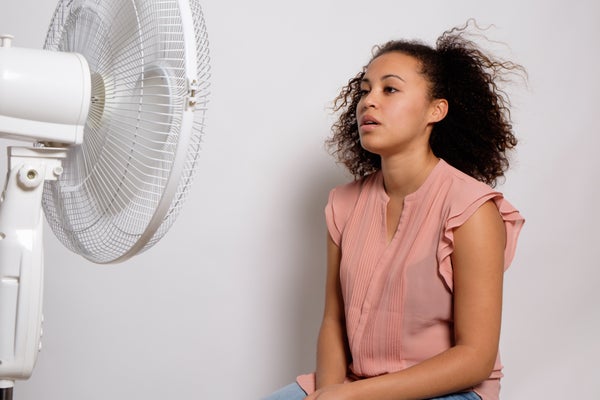Current official guidelines hold that fans are worse than useless in extreme heat. But new research shows they can still help cool people off in ultrahot conditions—as long as the humidity is relatively high.
Right now, government organizations such as the U.S. Environmental Protection Agency base their recommendations on either temperature or the heat index, which factors in temperature and humidity to reflect how hot it feels. The EPA’s Excessive Heat Events Guidebook warns against relying on fans when the heat index is above 99 degrees Fahrenheit. The World Health Organization’s Regional Office for Europe similarly cautions that “at temperatures above 35 [degrees Celsius (95 degrees F)] fans may not prevent heat related illness.”
In a new study, participants experiencing dry heat did indeed see their heart rate, temperature and risk of dehydration all increase with the use of a fan. But the fan provided relief when conditions were humid—even though the humidity made the heat index hotter.
On supporting science journalism
If you're enjoying this article, consider supporting our award-winning journalism by subscribing. By purchasing a subscription you are helping to ensure the future of impactful stories about the discoveries and ideas shaping our world today.
“We’re led to believe that [air-conditioning] is the only way in which we can cope with heat,” says Ollie Jay, co-author on the study, which was published Monday in Annals of Internal Medicine. That can create problems: “Not everybody has access to air-conditioning, because it’s expensive,” Jay says. “It’s also not particularly good for the environment.” Moreover, he adds, some cities struggle to supply enough electricity for air-conditioning during extreme heat events.
Jay and his colleagues recruited 12 volunteers to sit through two-hour simulations of hot conditions with and without a fan. One set of conditions was similar to the dry 2018 heat waves that struck Los Angeles and Ahmedabad, India. The other trials mimicked heat waves seen in 1995 in Chicago and in 2017 in Shanghai, with slightly lower temperatures but high humidity. Each scenario was above both the WHO and EPA cutoffs for fan use. Researchers tracked temperature, heart rate, blood pressure, discomfort and risk of dehydration (sweat rate).
In dry conditions, with a heat index of 46 degrees C (114.8 degrees F) and temperature of 47 degrees C (116.6 degrees F), almost all the heat stress indicators worsened when a fan was blowing. But in humid conditions, fans improved comfort—and even slightly lowered heart rate and temperature—on average, despite a sky-high heat index of 56 degrees C (132.8 degrees F) and a temperature of 40 degrees C (104 degrees F). Fan use increased the risk of dehydration in both scenarios, though.
Fans help sweat evaporate, Jay says, but that happens when air is dry anyway. So in very hot, dry conditions, fans merely bombard people with hot air. The results suggest, however, that the current recommendations may be unnecessarily conservative if humidity is high—as it often is during serious heat waves in much of the U.S.—and if one is young and healthy: all participants in this study were young men with no compromising conditions.
Older people, or anyone with a reduced ability to sweat, may suffer either way: a previous study Jay was involved in showed fans were harmful for older people even in higher humidity. But this new study emphasizes that overall fan effectiveness strongly depends on environmental conditions.
Additional work is needed to draw more detailed conclusions. “It shows the principle, but unfortunately, it’s not broad enough in the number of different climates to show you exactly when it changes from beneficial to nonbeneficial,” says George Havenith, a physiologist at Loughborough University in England, who was not involved in the study, though he advised Jay on his Ph.D., earned in 2002.The researchers will need to study vulnerable populations, as well as longer exposures—heat waves typically last longer than two hours—although Jay expects the effects would only be more dramatic in practice.
Jay points out that fans are not as effective as air-conditioning—but if government bodies eventually modify their recommendations, the devices could ease the burden on victims of heat waves everywhere, especially those without access to AC: “It’s really depriving people of a cheap, energy-efficient, and accessible cooling strategy that can be effective.”
